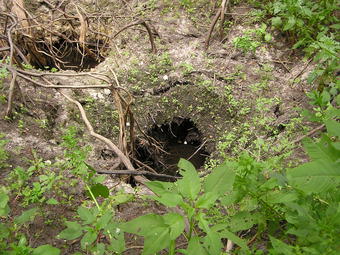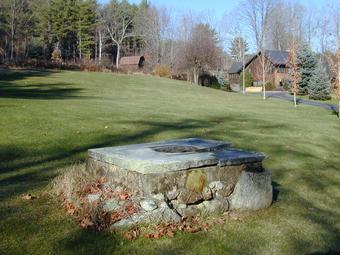
Groundwater, which flows out of sight through aquifers beneath our feet, is one of the Nation’s most important natural resources. In recognition of National Groundwater Awareness Week, March 5–11, 2017, here’s an opportunity to put your knowledge of this vital resource to the test!
Answers and explanations below
 Root-filled cavities showing underground flow. (Credit: Patty Metz, U.S. Geological Survey. Public domain.)
Root-filled cavities showing underground flow. (Credit: Patty Metz, U.S. Geological Survey. Public domain.)
What percentage of the Earth’s freshwater exists as groundwater?
Advertisement- About 1%
- About 10%
- About 20%
- About 30%
- How much groundwater, on average, is withdrawn across the United States every day?
- About 79,000 million gallons per day (Mgal/d)
- About 7,900 Mgal/d
- About 790 Mgal/d
- About 79 Mgal/d
- True or false? Because the ground filters water, groundwater is always clean.
- Groundwater is used for which of the following:
- Aquaculture
- Mining
- Irrigation
- All of the above
Old well with granite top. (Credit: Joseph Ayotte, U.S. Geological Survey. Public domain.)
- It wouldn’t be a groundwater pop quiz without a few questions on wells. Which of the following is not a type of groundwater well?
- Dipped
- Dug
- Driven
- Drilled
- True or false? A well can be pumped so much that it causes the water level in nearby wells to be lowered.
- True or false? Pumping of a well can reverse the natural flow of groundwater into a river, causing the water level in the river to fall.
- True or false? Water can flow in streams even during periods of drought due to groundwater seeping into streams.
- Which state, according to our 2010 water use report, is the largest withdrawer of groundwater in the United States?
- Rhode Island
- California
- Texas
- Florida
- True or false? Because of the interconnectedness of the water cycle, groundwater is composed of water that falls from the sky, water that seeps into the ground from streams and rivers, and snowmelt that infiltrates the ground.
- If you guessed 4. About 30%, you got it. Approximately 2.5% of Earth’s water is freshwater and almost all of it is locked up in ice (68.7%) and the ground (30.1%). For a visual representation, check out these cool diagrams.
- This one might surprise you but the answer is 1. About 79,000 Mgal/d. According to our 2010 water use report (page 14) the United States, including Puerto Rico and the U.S. Virgin Islands, withdraws 79,300 Mgal/day of groundwater. This includes both fresh and saline water.
- This one’s false.Naturally, big particles that can be found in streams, like leaf chunks and other suspended matter, are filtered out. But groundwater can contain other items that are harder to see. Some are naturally occurring, like hydrogen sulfide and other naturally occurring chemicals, while others are human-made substances, like petroleum, organic compounds, or other chemicals introduced by human activities.
Contaminated groundwater can occur if, for example, a well is located near land that is used for farming where pesticides and fertilizers seep into the soil, or near a gas station that has a leaking storage tank. Leakage from septic tanks and waste-disposal sites can also contaminate groundwater by introducing bacteria to the water. These different types of contamination can eventually end up in water drawn from a well.
- If you guessed 4. All of the above, you got it! Groundwater has a number of uses, including the ones listed above. Defined broadly, other uses include meeting livestock needs, thermoelectric power production, and domestic and industrial water use.
- Dug, driven, and drilled are all types of groundwater wells so if you guessed 1. Dipped, you’re correct! A quick overview of well types:Dug wells – Historically, dug wells were excavated by hand shovel to below the water table until incoming water exceeded the digger’s bailing rate. The well was lined with stones, brick, tile, or other material to prevent collapse, and was covered with a cap of wood, stone, or concrete. They cannot be dug much deeper than the water table because they will keep filling up with water.
Driven wells – While dug wells have become less popular, driven wells are still common today. They are built by driving a small-diameter pipe into soft earth, such as sand or gravel. A screen is usually attached to the bottom of the pipe to filter out sand and other particles. These wells can only tap shallow water and, because the source of the water is so close to the surface, contamination from surface pollutants can occur.
Drilled wells – Most modern wells are drilled, which requires a drill rig. Drill rigs are often mounted on big trucks. They use rotary drill bits that chew away at the rock, percussion bits that smash the rock or, if the ground is soft, large auger bits. Drilled wells can be drilled more than 1,000 feet deep. Often, a pump is placed in the well at some depth to push the water up to the surface. - True!Water levels in wells are constantly changing both in the short term and over the long term. Some wells even have a seasonal change. A well may be pumped so much that it causes the water level in nearby wells to be lowered, too. This all depends on how fast the aquifer that the wells use is resaturated with water from the surface or from the area surrounding it (recharge). In some places, people have withdrawn water faster than water replenishes the aquifer, and the groundwater level drops below the intake pump or, in some cases, below the bottom of the well. Sometimes this is a long-term problem occurring over a very large area. If it takes a long time to replenish the aquifer, maybe because the aquifer is composed of rock that only allows water to move through it very slowly, a field of wells may stop producing. In a severe drought water levels in wells can significantly decline.
- This one’s true!Some, and often a great deal, of the water flowing in rivers comes from seepage of groundwater into the streambed. Groundwater pumping can alter how water moves between an aquifer and a stream, lake, or wetland by either intercepting groundwater flow that empties into the surface-water body under natural conditions or by increasing the rate of water movement from the surface-water body into an aquifer.
- Lucky for the fish, this is true!Although we only see surface water on the Earth’s surface, there is a strong connection between nature’s surface-water and groundwater systems. Groundwater contributes to streams in nearly all geographic areas and climates and can be an alternative or supplemental source of water during periods of surface-water drought if sufficient groundwater resources exist.
The proportion of stream water that comes from groundwater inflow varies according to a region’s geography, geology, and climate. The USGS studied streams in the United States (page 12) to see how much of the streamflow came from groundwater flow. The Forest River basin in North Dakota is underlain by poorly permeable (water moves through it relatively slowly) silt and clay deposits, and only about 14 percent of its average-annual flow comes from groundwater. In contrast, the Sturgeon River basin in Michigan is underlain by highly permeable (water moves through it relatively quickly) sand and gravel, and about 90 percent of its average-annual flow comes from groundwater. As the picture above shows, during non-drought periods, clear freshwater flows to the land surface (left). During a drought, groundwater levels fell to a level that no longer “fed” the spring, resulting in a stagnant pond.
- The correct answer is 2. California. The 2010 water use report provides estimates of water use across different types and for states across the country.
- If you guessed true, you got it. Check out this fun diagram to explore the water cycle.
Print this page
